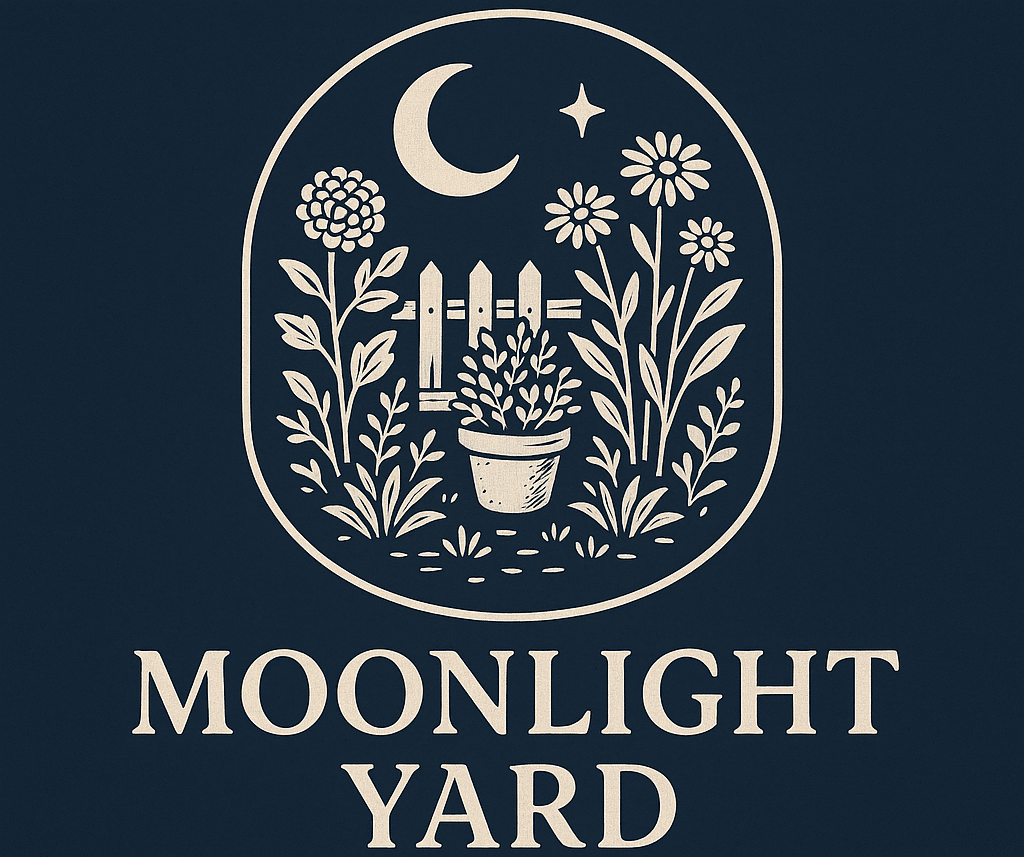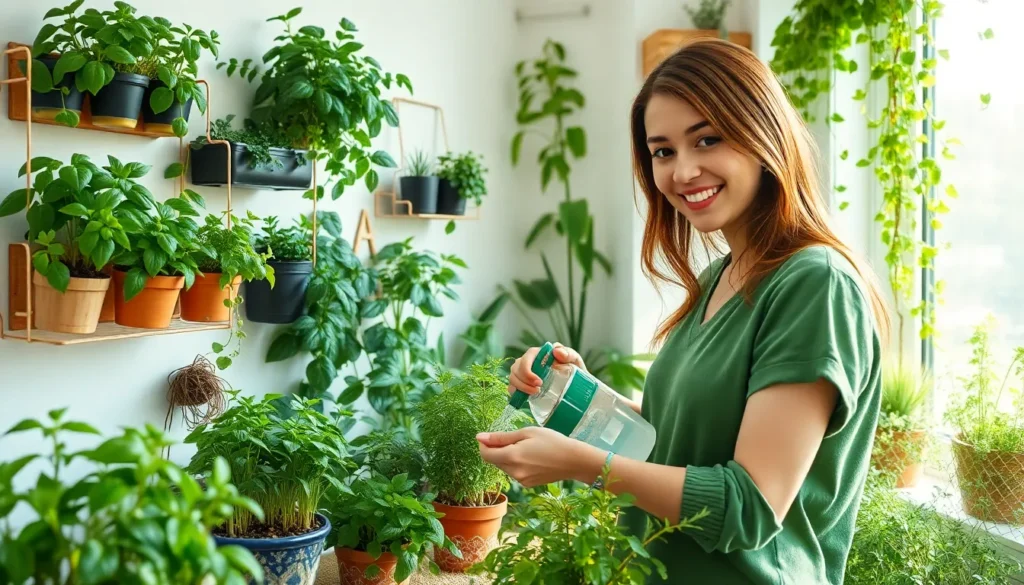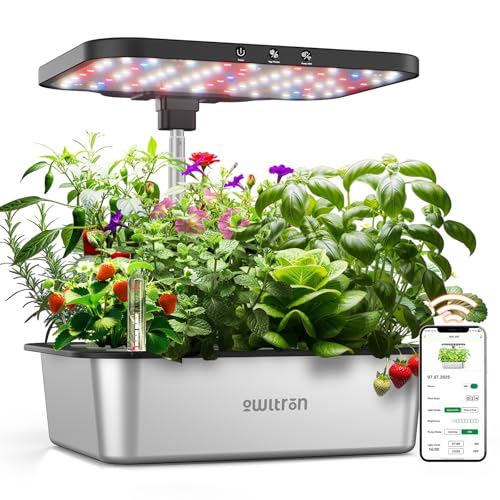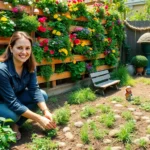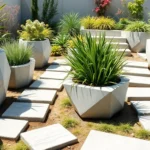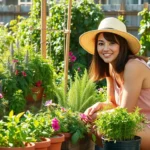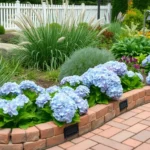We’ve all felt that longing for fresh greenery during long winter months or when living in urban spaces with limited outdoor access. Indoor gardening transforms any living space into a vibrant oasis while providing fresh herbs, vegetables, and beautiful plants year-round.
Whether you’re working with a spacious sunroom or a tiny apartment corner, we’ll show you how to create thriving indoor gardens that fit your lifestyle and space constraints. From vertical wall gardens that maximize small areas to hydroponic systems that produce impressive yields, there’s an indoor gardening solution for every home.
The benefits extend far beyond aesthetics – indoor gardens improve air quality, reduce grocery bills, and provide the satisfaction of growing your own food. We’ve compiled proven techniques and creative ideas that’ll help you build a flourishing indoor garden regardless of your experience level or available space.
Herb Gardens That Transform Your Kitchen Into a Culinary Haven
Fresh herbs elevate every dish from ordinary to extraordinary, and growing them indoors means you’ll always have aromatic ingredients at your fingertips.
Popular Herbs for Indoor Growing
Basil thrives in warm kitchen environments and produces fragrant leaves perfect for pasta, pizza, and caprese salads. We recommend starting with Genovese or Thai varieties since they adapt well to container growing and provide continuous harvests when you pinch flowers regularly.
Mint grows vigorously indoors and offers refreshing flavor for teas, cocktails, and Middle Eastern dishes like tabbouleh. Keep mint in its own container because it spreads rapidly and can overtake other herbs in shared planters.
Parsley delivers fresh taste year round and comes in flat leaf and curly varieties that both excel in indoor conditions. This versatile herb enhances soups, sauces, and garnishes while providing vitamin C and antioxidants.
Chives produce delicate onion flavor and beautiful purple flowers that make excellent edible garnishes. These hardy herbs tolerate lower light conditions better than most kitchen herbs and regrow quickly after harvesting.
Rosemary brings Mediterranean aromatics to your cooking and releases pine like fragrance that naturally freshens kitchen air. This woody herb prefers slightly drier soil conditions and works wonderfully with roasted vegetables and meats.
Oregano offers robust flavor essential for Italian and Greek cuisine while requiring minimal care once established. We suggest Mexican oregano for spicier dishes and Greek oregano for traditional Mediterranean recipes.
Container Options for Kitchen Herb Gardens
Terra cotta pots provide excellent drainage and allow roots to breathe while adding rustic charm to kitchen windowsills. These classic containers come in sizes from 4 to 12 inches and work perfectly for single herb plantings or small collections.
Hanging planters maximize vertical space and create living curtains near kitchen windows or above prep areas. Macrame holders and metal hanging baskets both accommodate standard pots while adding visual interest to unused wall space.
Window box planters stretch across windowsills and accommodate multiple herbs in one elongated container. We prefer boxes with drainage holes and water catch trays that protect surfaces from moisture damage.
Tiered plant stands organize herbs at different heights and make harvesting easier while creating attractive displays. These multi level systems work especially well in corners or against walls where floor space is limited.
Mason jars serve as temporary growing containers for herbs rooted in water like basil and mint. These clear containers let you monitor root development while adding farmhouse style to kitchen counters and shelves.
Placement and Lighting Requirements
South facing windows receive 6 to 8 hours of direct sunlight daily and create ideal growing conditions for most culinary herbs. Position heat loving herbs like basil and rosemary closest to these bright exposures for maximum growth rates.
East facing windows provide gentle morning light that works well for herbs preferring partial sun conditions like parsley and chives. These locations offer bright illumination without the intense afternoon heat that can stress delicate herb foliage.
LED grow lights supplement natural light and extend growing seasons for herbs placed away from windows. We recommend full spectrum LED fixtures positioned 6 to 12 inches above plants and operated for 12 to 16 hours daily.
Kitchen counters near windows offer convenient access for daily harvesting while keeping herbs within easy reach during cooking. Ensure adequate air circulation around containers to prevent fungal issues in humid kitchen environments.
Floating shelves mounted near windows create additional growing space without blocking natural light from reaching plants below. These installations work particularly well for displaying smaller herb containers and creating layered garden displays.
Succulent Displays That Add Modern Elegance to Any Room
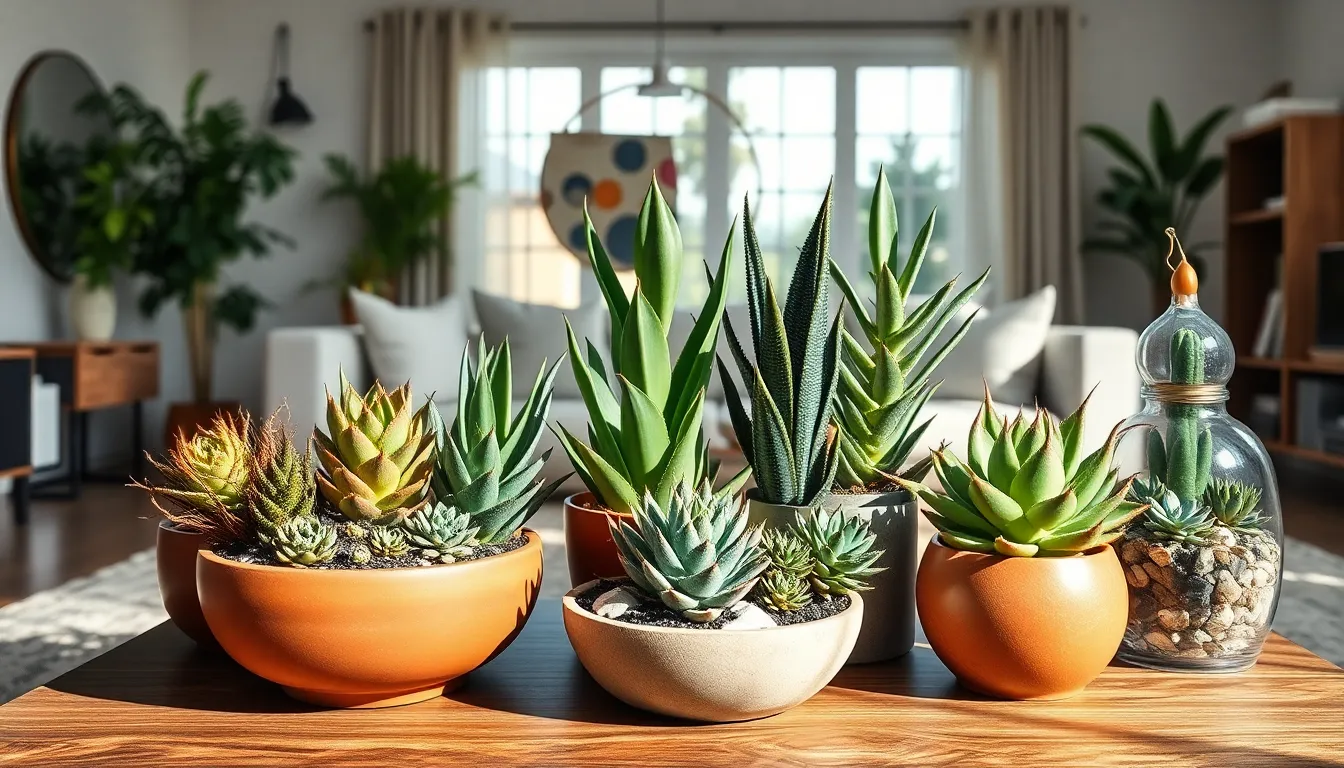
Moving beyond herbs, we can transform our indoor spaces with sophisticated succulent arrangements that require minimal care while delivering maximum visual impact.
Low-Maintenance Succulent Varieties
Haworthias offer striking zebra-like patterns and compact growth habits that make them perfect for small spaces. These architectural plants thrive in bright indirect light and need watering only once every 2-3 weeks.
Gasterias provide unique tongue-shaped leaves with spotted or banded patterns that create visual interest without demanding constant attention. We love how they adapt to various lighting conditions and forgive occasional watering lapses.
Aloe Vera combines practical benefits with aesthetic appeal, offering both medicinal properties and sculptural beauty. This versatile plant grows steadily in sunny windows and produces occasional dramatic flower spikes.
String Of Bananas creates cascading displays that work beautifully in hanging arrangements or tall containers. Its trailing nature adds vertical dimension to our indoor garden designs while requiring water only when the soil completely dries.
Christmas Cactus brings seasonal color to our succulent collections with vibrant blooms that appear during winter months. Unlike desert cacti, this variety prefers slightly more moisture and indirect light.
Creative Container Ideas for Succulent Gardens
Large Succulent Planters accommodate multiple varieties in single displays that create stunning focal points for living rooms or entryways. We recommend choosing containers at least 12 inches wide to allow proper root development and visual balance.
Wooden Boxes bring rustic charm to modern succulent arrangements while providing excellent drainage when lined with industry fabric. Cedar and teak options resist moisture damage and complement the natural textures of succulent foliage.
Glass Terrariums showcase our smallest succulent varieties in controlled environments that highlight their intricate details. Open-top designs prevent moisture buildup that can harm these drought-adapted plants.
Terracotta Bowls create classic Mediterranean aesthetics that complement succulent colors and textures perfectly. Their porous material helps regulate soil moisture while adding earthy warmth to contemporary spaces.
Concrete Planters deliver sleek modern lines that emphasize the architectural qualities of sculptural succulents like agaves and echeverias. We prefer lightweight concrete mixes that won’t strain shelving or tabletops.
Arrangement Tips for Visual Impact
Mix Textures by combining smooth jade plants with spiky aloes and fuzzy lamb’s ear succulents for arrangements that invite touch and exploration. Contrasting leaf surfaces create depth and prevent monotonous displays.
Select Complementary Colors using the color wheel to pair blue-green sedums with coral-toned echeverias or purple-leaved aeoniums. We avoid using more than three main colors to maintain sophisticated restraint.
Maintain Balance through careful placement of larger statement plants like barrel cacti alongside clusters of smaller rosette succulents. Odd numbers create more natural-looking groupings than symmetrical pairs.
Layer Heights using plant stands, books, or inverted pots to create multiple viewing levels within single arrangements. This technique maximizes visual interest in compact spaces while ensuring each plant receives adequate light.
Vertical Gardens That Maximize Space in Small Homes
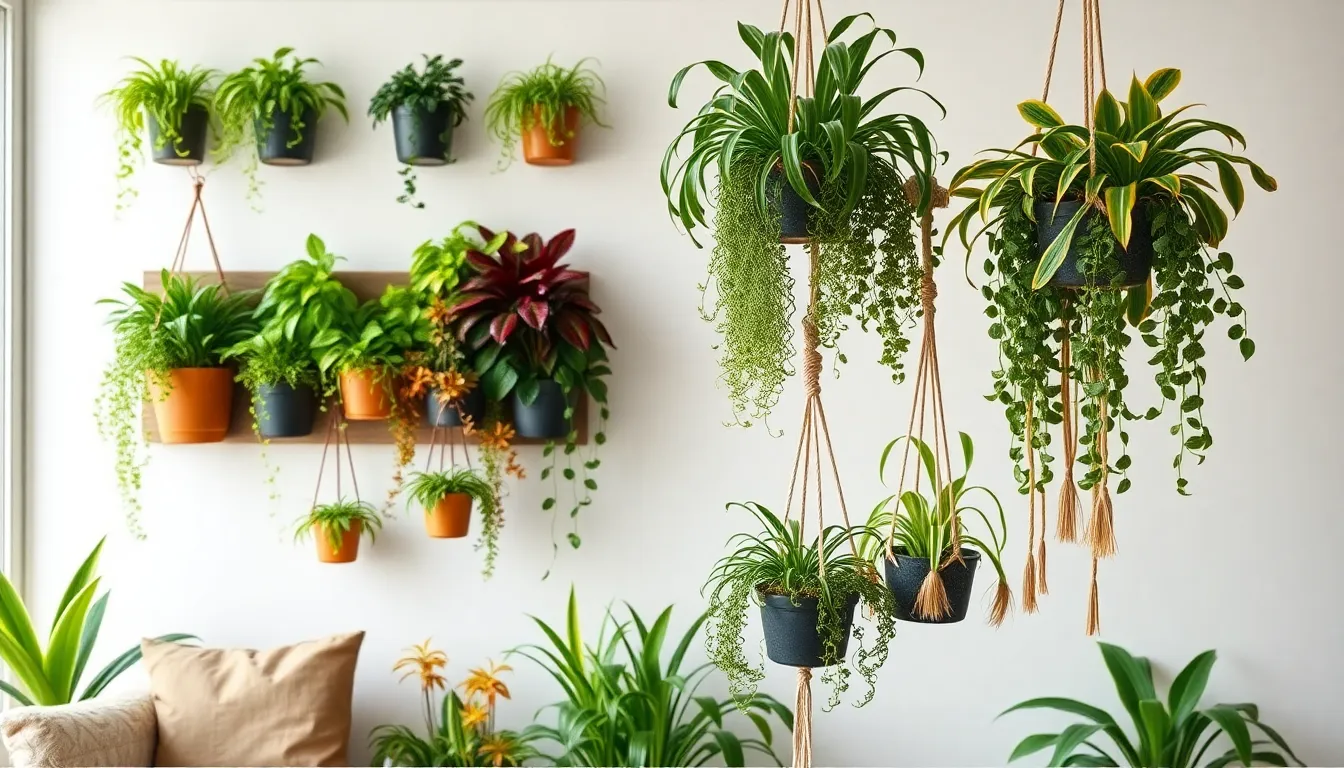
Space constraints don’t have to limit our gardening dreams when we use vertical growing answers. Vertical gardens transform empty walls into thriving green spaces that bring nature indoors without sacrificing valuable floor area.
Wall-Mounted Planter Systems
Wall mounted systems offer incredible flexibility for creating customized vertical gardens in any indoor space. Eco Planters provide an excellent starting point with their variety of colors that allow us to create striking color-blocking patterns across our walls. Multi-tiered container gardens use existing planters of different sizes to build layered effects while ensuring proper drainage throughout the system.
Modular wall systems integrate seamlessly with our interior design by incorporating plants directly into living walls. These systems can be customized with various planter sizes and designs to fit our exact space requirements and aesthetic preferences.
Hanging Garden Answers
Hanging baskets create visual interest by utilizing ceiling space and walls for our vertical gardening needs. We can mix different plants in these baskets to add ever-changing layers and textures to our indoor spaces.
Macramé plant hangers bring a bohemian touch to our vertical gardens while supporting potted plants at various heights. These hangers work particularly well for trailing plants that cascade downward, creating natural curtains of greenery.
DIY Vertical Garden Projects
Upcycled vertical gardens transform plastic bottles and other recyclable materials into unique vertical planters that reduce waste while maximizing growing space. Pallet gardening repurposes wooden pallets by attaching planters or creating direct planting spaces within the pallet structure.
Ladder gardens convert old ladders into functional growing systems by attaching planters or window boxes to the rungs at different heights. This approach creates an attractive stepped display that accommodates plants with varying light and water requirements throughout the vertical structure.
Hydroponic Systems That Deliver Fresh Produce Year-Round
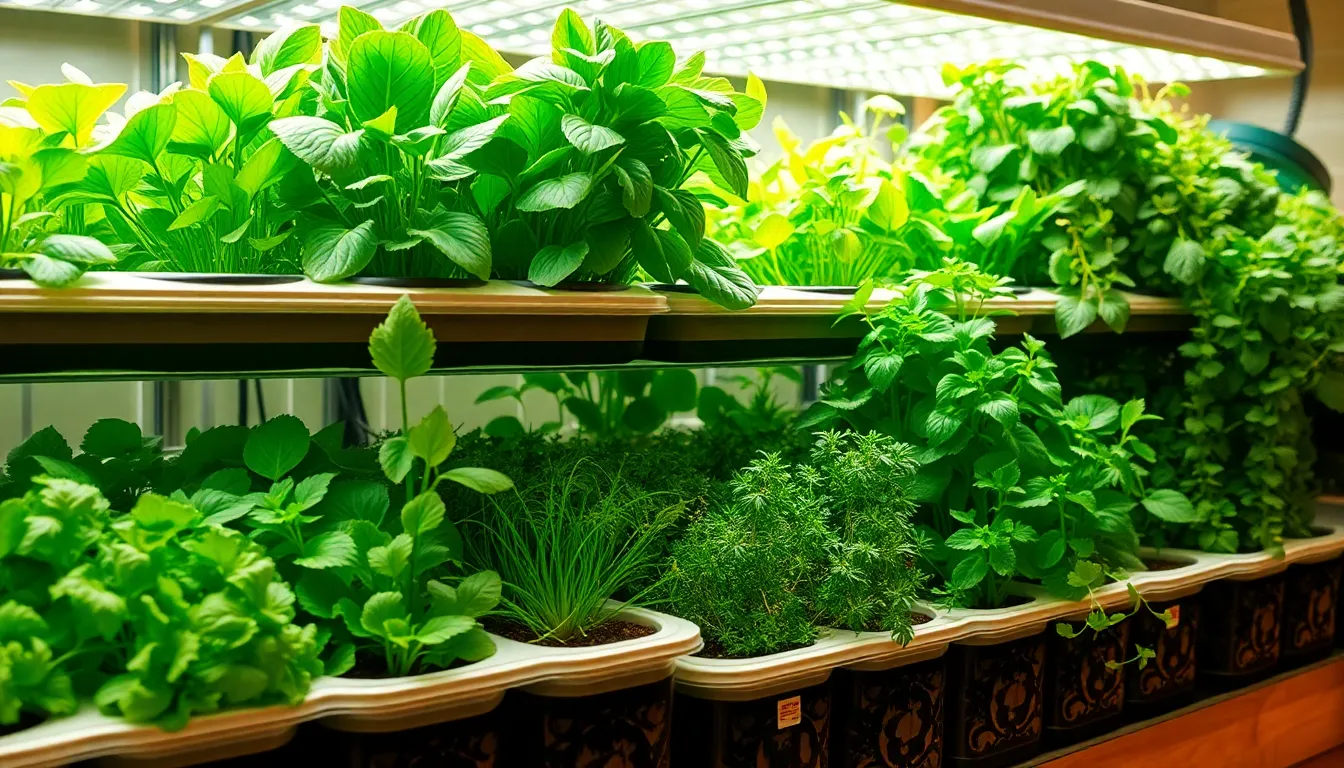
Building on the foundation of herb and vertical gardens, we can take our indoor gardening to the next level with hydroponic systems that produce fresh vegetables and herbs throughout the year. These soil-free growing systems use nutrient-rich water to cultivate plants, delivering consistent harvests regardless of outdoor weather conditions.
Beginner-Friendly Hydroponic Setups
AeroGarden systems make hydroponic gardening accessible for newcomers with their simple plug-and-play design. These countertop units feature built-in LED grow lights and automated watering schedules that eliminate guesswork for first-time growers.
Click & Grow Smart Garden offers another user-friendly option with pre-seeded plant pods and smart soil technology. The system automatically manages watering and nutrients while mobile app integration tracks plant progress and sends care reminders.
LetPot systems combine integrated sensors with mobile app control to simplify maintenance tasks. These units monitor water levels, nutrients, and lighting conditions while sending notifications when intervention is needed.
Gardyn units provide vertical growing towers perfect for maximizing small spaces. Their intuitive controls and automated features make them ideal for beginners who want higher yields without complex setup requirements.
Best Vegetables for Indoor Hydroponic Growing
Leafy greens represent the most productive and reliable crops for indoor hydroponic systems. Lettuce varieties like butterhead and romaine thrive in these controlled environments while producing multiple harvests from single plantings.
Fresh herbs including basil, cilantro, parsley, and chives flourish under hydroponic conditions. These aromatic plants grow faster than their soil-grown counterparts and provide continuous harvests for culinary use.
Asian vegetables such as bok choy and chard adapt exceptionally well to hydroponic growing. These nutrient-dense crops mature quickly and offer unique flavors for diverse cooking applications.
Compact fruiting plants like cherry tomatoes, small peppers, and strawberries can succeed indoors with proper lighting and nutrient management. While requiring more attention than leafy crops, these plants deliver rewarding harvests of fresh produce.
Microgreens provide the fastest turnaround for hydroponic growers, reaching harvest size in just 7-14 days. These nutrient-packed seedlings offer intense flavors and high yields in minimal space.
Equipment and Maintenance Requirements
Full-spectrum LED grow lights serve as the foundation for successful indoor hydroponic growing. Systems like Rise Garden use 65W LEDs per level to provide optimal light intensity for plant photosynthesis and healthy development.
Modular container systems with stackable units maximize growing space while maintaining organized layouts. These multi-level designs feature adjustable water reservoirs that accommodate different plant sizes and growth stages.
Nutrient answers require regular monitoring to maintain proper plant health and productivity. Balanced liquid fertilizers designed specifically for hydroponic systems deliver essential minerals that plants normally absorb from soil.
Support structures including net pots and grow sponges anchor plant roots while allowing proper water and nutrient circulation. These materials prevent root damage while supporting healthy plant development.
Smart automation features reduce maintenance workload through mobile app integration and sensor monitoring. Advanced systems track water levels, nutrient concentrations, and lighting schedules while sending maintenance alerts to users.
Regular maintenance tasks involve monitoring water quality, trimming mature plants, and harvesting produce at peak ripeness. Clean equipment prevents disease while proper plant spacing ensures adequate light and nutrient distribution for optimal yields.
Terrarium Gardens That Create Miniature Ecosystems
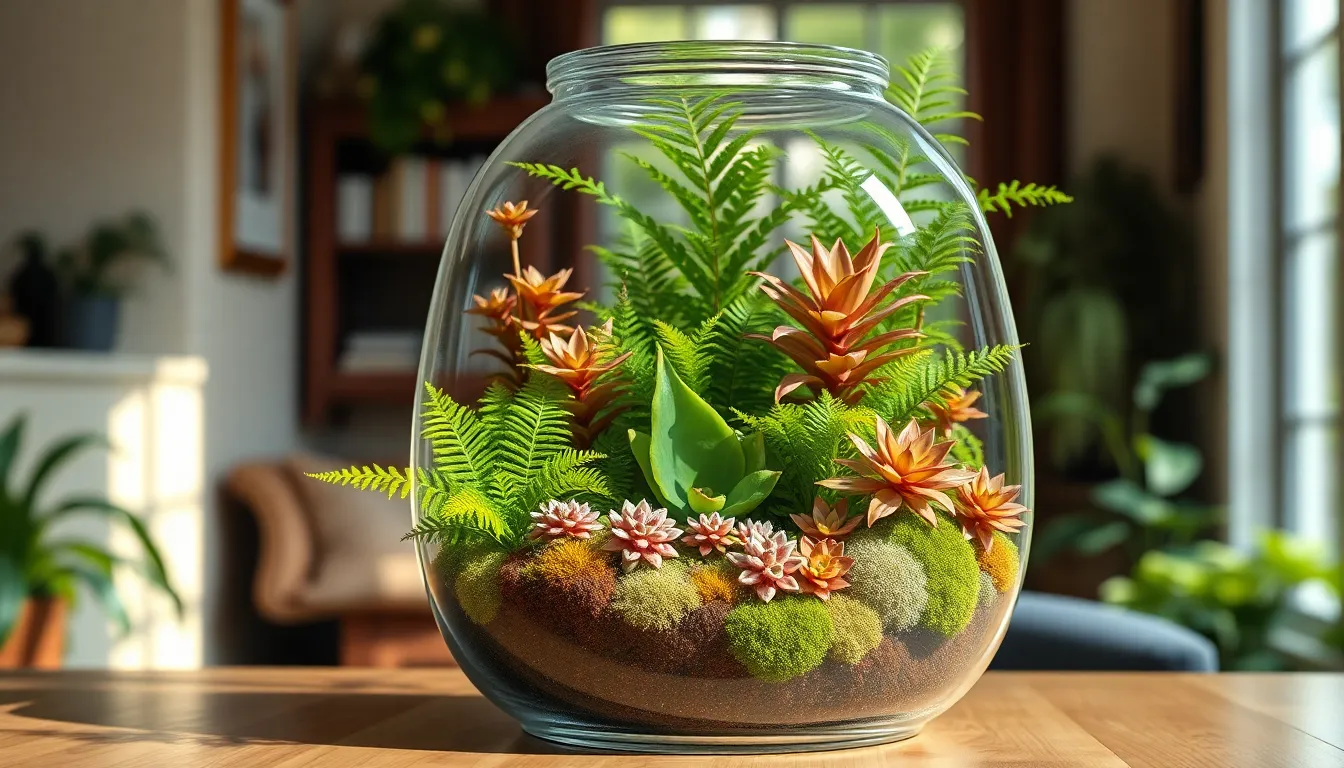
Terrariums bring the magic of nature indoors by creating self-contained miniature worlds that replicate natural ecosystems. These glass enclosed gardens offer a perfect solution for indoor gardening enthusiasts who want to cultivate plants in controlled environments.
Closed Terrarium Plant Selection
Ferns thrive exceptionally well in closed terrarium environments due to their natural preference for humid conditions. Boston Fern and White Rabbit’s Foot Fern specifically excel in these moisture-rich environments, creating lush green backdrops for your miniature network.
Fittonia plants make stunning focal points with their vibrant colored leaves that add visual interest to any closed terrarium. These nerve plants flourish in low to moderate indirect light conditions while requiring minimal maintenance once established.
Pilea varieties bring unique textures and colors to closed terrariums with options like ‘Greyzy’ and ‘Aquamarine’ cultivars. Their compact growth habit makes them ideal companions for other humidity loving plants in enclosed environments.
Mosses create beautiful living carpets that establish the foundation layer of your terrarium network. Carpet Moss and Cushion Moss varieties spread naturally to form dense green mats that retain moisture and provide habitat for your miniature garden.
Open Terrarium Design Ideas
Succulent arrangements work beautifully in open terrariums where improved air circulation prevents moisture buildup that can harm these drought tolerant plants. Cacti and various succulent species create striking architectural displays while requiring minimal watering schedules.
Herb gardens transform open terrariums into functional growing spaces where you can cultivate fresh mint and basil for culinary use. These aromatic plants benefit from the increased airflow while providing fresh ingredients for your kitchen.
Flowering displays add vibrant colors to open terrarium designs with plants like African violets that bloom repeatedly under proper lighting conditions. Small flowering plants create focal points while maintaining the scale appropriate for terrarium environments.
Maintenance and Care Tips
Lighting requirements for most terrarium plants involve providing low to moderate indirect light to prevent leaf burn and excessive heat buildup. Position your terrariums near windows with filtered sunlight or supplement with LED grow lights for consistent illumination.
Watering schedules differ significantly between closed and open terrarium systems based on their moisture retention capabilities. Closed terrariums require minimal watering since they recycle moisture naturally, while open terrariums need more frequent watering based on individual plant requirements and environmental conditions.
Humidity management happens automatically in closed terrariums through natural water cycle processes, but open terrariums may require external humidification methods. Monitor your plants for signs of stress and adjust environmental conditions accordingly to maintain optimal growing conditions.
Window Sill Gardens That Utilize Natural Light Perfectly
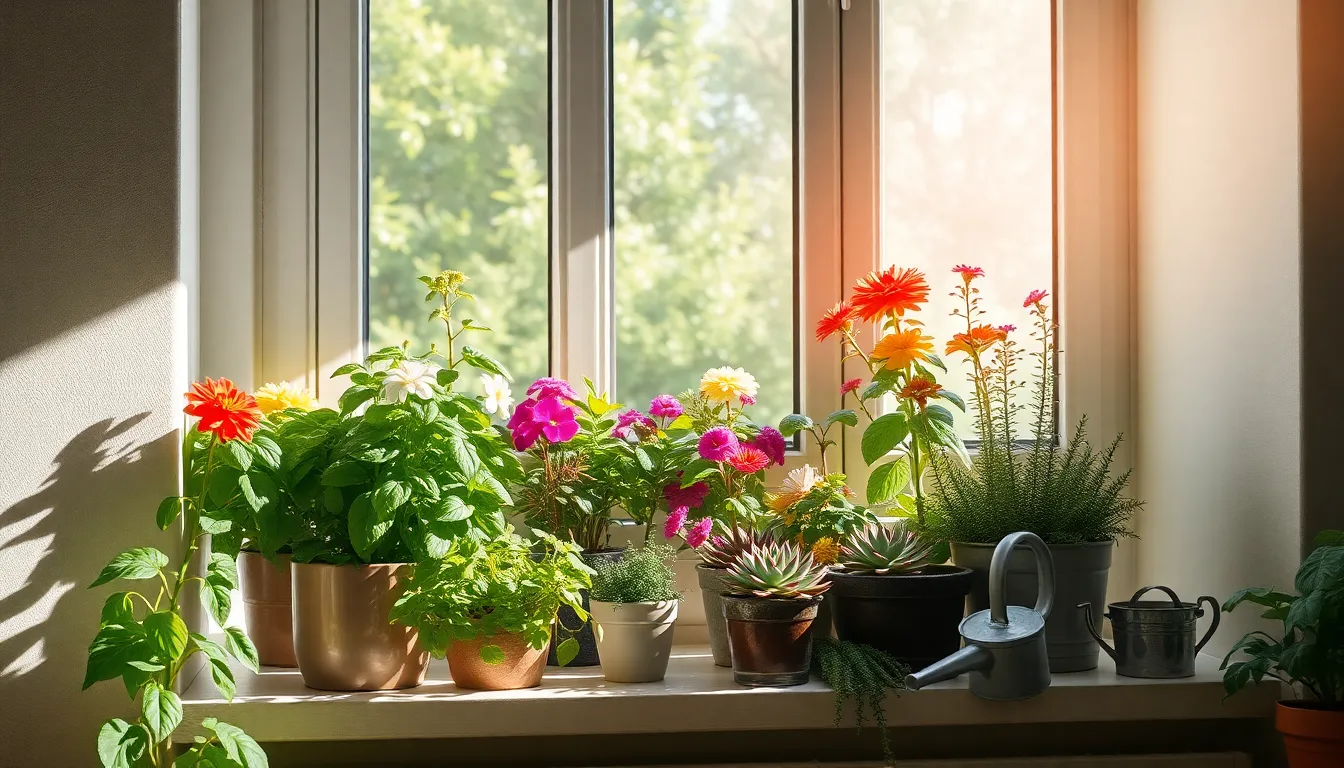
Moving from larger indoor garden concepts to more compact answers, we find that window sill gardens offer the perfect marriage of convenience and natural lighting. These miniature green spaces transform ordinary windows into thriving plant sanctuaries without requiring extensive setup or specialized equipment.
Ideal Plants for Window Gardens
Herbs form the backbone of successful window gardens because they thrive in well-lit conditions and provide immediate culinary benefits. Basil grows rapidly in south-facing windows, requiring at least 4-6 hours of direct sunlight daily. Mint spreads easily in containers and tolerates varying light conditions throughout the day. Rosemary develops aromatic oils when exposed to consistent sunlight and well-draining soil.
Microgreens excel in window gardens since they need minimal light and mature within 7-14 days. These nutrient-dense seedlings include varieties like radish, pea shoots, and wheatgrass that add fresh flavors to salads and garnishes. Growing cycles remain short, allowing for continuous harvests throughout the season.
Succulents adapt beautifully to window environments because they store water and handle fluctuating light conditions. Haworthias display striking geometric patterns while requiring minimal watering. Aloe vera provides both aesthetic appeal and practical healing properties for household use. String of bananas creates cascading displays that soften window edges.
Seasonal Window Garden Rotations
Spring rotations bring vibrant colors after winter’s dormancy through colorful annuals like marigolds and petunias. These flowering plants establish quickly in warming temperatures and provide continuous blooms for 8-12 weeks. Seed starting becomes particularly rewarding during this season as natural daylight hours increase.
Summer focuses on heat-loving herbs and drought-tolerant succulents that flourish in intense window light. Oregano and thyme develop concentrated flavors during hot months. Echeveria and jade plants store moisture efficiently while creating sculptural displays that complement summer’s bright atmosphere.
Fall transitions feature plants with autumn colors like asters and chrysanthemums that mirror outdoor seasonal changes. These flowering perennials provide 4-6 weeks of vibrant displays before winter dormancy. Herb harvesting reaches its peak as plants concentrate essential oils before cold weather arrives.
Winter incorporates evergreen ferns and seasonal bulbs that create winter wonderland effects indoors. Boston ferns maintain lush greenness throughout cold months while improving indoor air quality. Forced bulbs like paperwhites and crocuses provide fragrant blooms that brighten short winter days.
Optimizing Light Exposure
South-facing windows deliver optimal growing conditions because they receive direct sunlight for 6-8 hours daily. We position plants within 12 inches of glass surfaces to maximize light absorption while avoiding heat buildup from direct contact. Rotating containers weekly ensures even growth patterns and prevents plants from leaning toward light sources.
Temperature consistency between 70-75°F maintains ideal growing conditions throughout seasonal changes. We avoid placing containers near heating vents or cooking appliances that create temperature fluctuations and reduce humidity levels. Digital thermometers help monitor microclimates around different window exposures.
External obstructions like tree branches or building shadows can reduce available light by 30-50% during certain times of day. We trim nearby vegetation when possible and relocate plants to unobstructed windows during peak growing seasons. Grow lights supplement insufficient natural light during winter months when daylight hours decrease significantly.
Reflective surfaces behind plants increase available light through strategic placement of mirrors or white surfaces. These modifications can boost light levels by 15-25% without additional energy costs. Cleaning windows monthly removes dust and film that blocks up to 10% of available sunlight from reaching our plants.
Air-Purifying Plant Gardens That Improve Indoor Air Quality
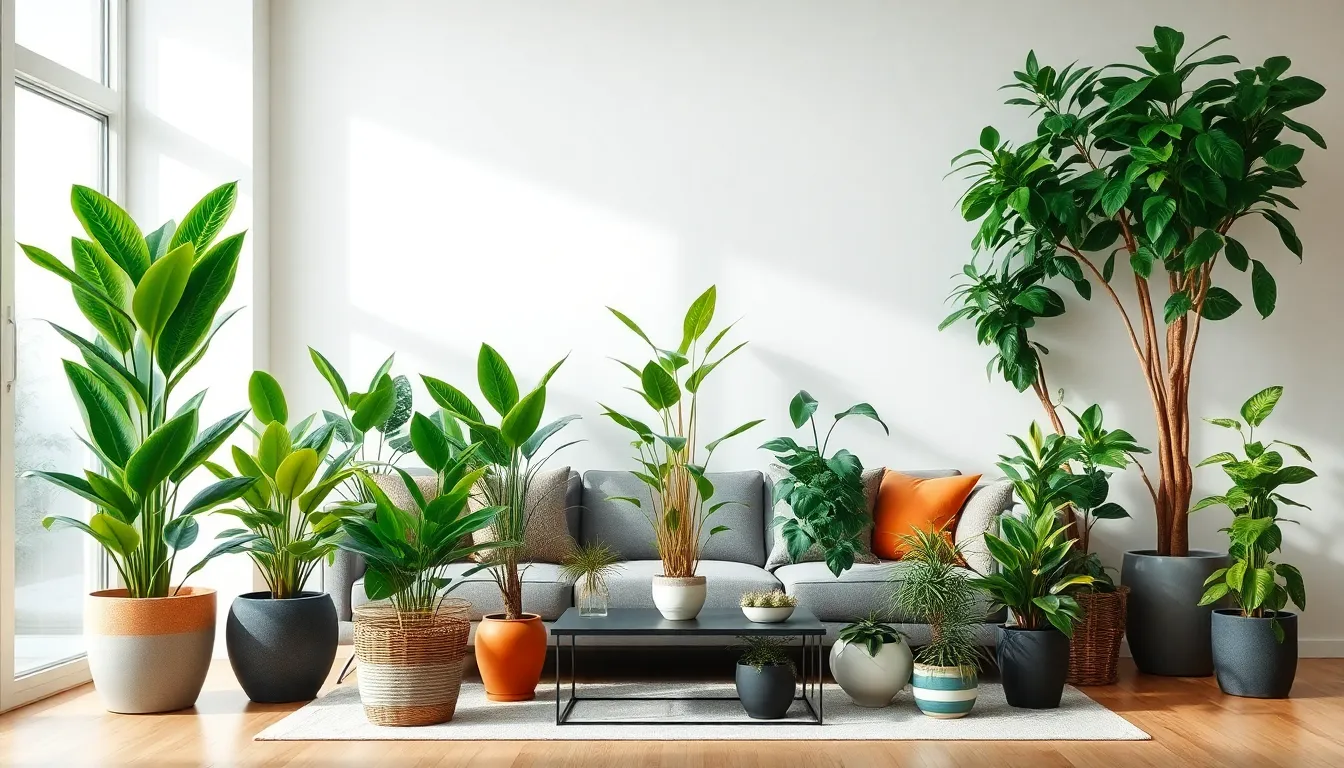
Air purifying plant gardens offer us the perfect opportunity to enhance our indoor environments while enjoying beautiful greenery. These living air filters work continuously to remove harmful chemicals and pollutants from our homes.
Top Air-Purifying Plants for Indoor Spaces
Snake Plant (Sansevieria Trifasciata) stands out as our top choice for beginners who want maximum air purification with minimal effort. This resilient plant removes impurities from the air while requiring water only once every 2-3 weeks, making it perfect for busy lifestyles.
Golden Pothos (Epipremnum aureum) excels at eliminating four major indoor pollutants: xylene, carbon monoxide, formaldehyde, and benzene. We love how its trailing vines create cascading displays while working overtime to clean our air, especially near furniture and carpeted areas.
Ficus plants (Ficus spp.) provide us with dual benefits by absorbing carbon dioxide during the day and releasing fresh oxygen into our living spaces. These elegant trees adapt well to various light conditions and can grow into stunning focal points for larger rooms.
English Ivy (Hedera helix) removes multiple pollutants while adding sophisticated decorative appeal to our indoor gardens. This versatile climber works beautifully in hanging baskets or trained along walls, creating living art that purifies our air simultaneously.
Strategic Placement for Maximum Benefits
Minimal airflow areas become prime locations for our air purifying plants since stagnant air allows them to process pollutants more effectively. We position plants in corners, behind furniture, and in rooms with limited ventilation to maximize their cleaning potential.
Pollution source proximity guides our placement strategy as we locate plants near furniture, carpets, and electronics that emit harmful chemicals. Placing a Golden Pothos near our sofa or a Snake Plant beside our entertainment center targets these emission sources directly.
Vertical growing answers help us maximize both space and aesthetic appeal through hanging baskets and wall mounted systems. We create layered displays that purify air at multiple levels while transforming bare walls into living features.
Room size calculations determine how many plants we need, with experts recommending 1-2 plants per 100 square feet for noticeable air quality improvements. We distribute plants throughout larger spaces rather than clustering them in single areas for better coverage.
Combining Beauty with Functionality
Mixed plant arrangements create visually stunning displays by combining different shapes, sizes, and textures in our air purifying gardens. We pair the upright structure of Snake Plants with the flowing vines of Pothos and the broad leaves of Ficus for ever-changing compositions.
Decorative integration transforms functional air purifiers into artistic elements through unique planters, terrariums, and creative containers. We incorporate plants into our existing decor using ceramic pots, woven baskets, and modern geometric planters that complement our interior design.
Balanced density ensures proper air circulation around our plants while maintaining their purifying effectiveness. We avoid overcrowding plants and leave adequate space between containers, allowing air to move freely through our indoor garden arrangements.
Mechanical air purifier partnerships provide us with optimal air quality results since plants alone cannot remove all indoor pollutants. We combine our living air filters with HEPA filter systems for comprehensive air cleaning that addresses both chemical pollutants and particulate matter.
Edible Indoor Gardens That Provide Fresh Ingredients Daily
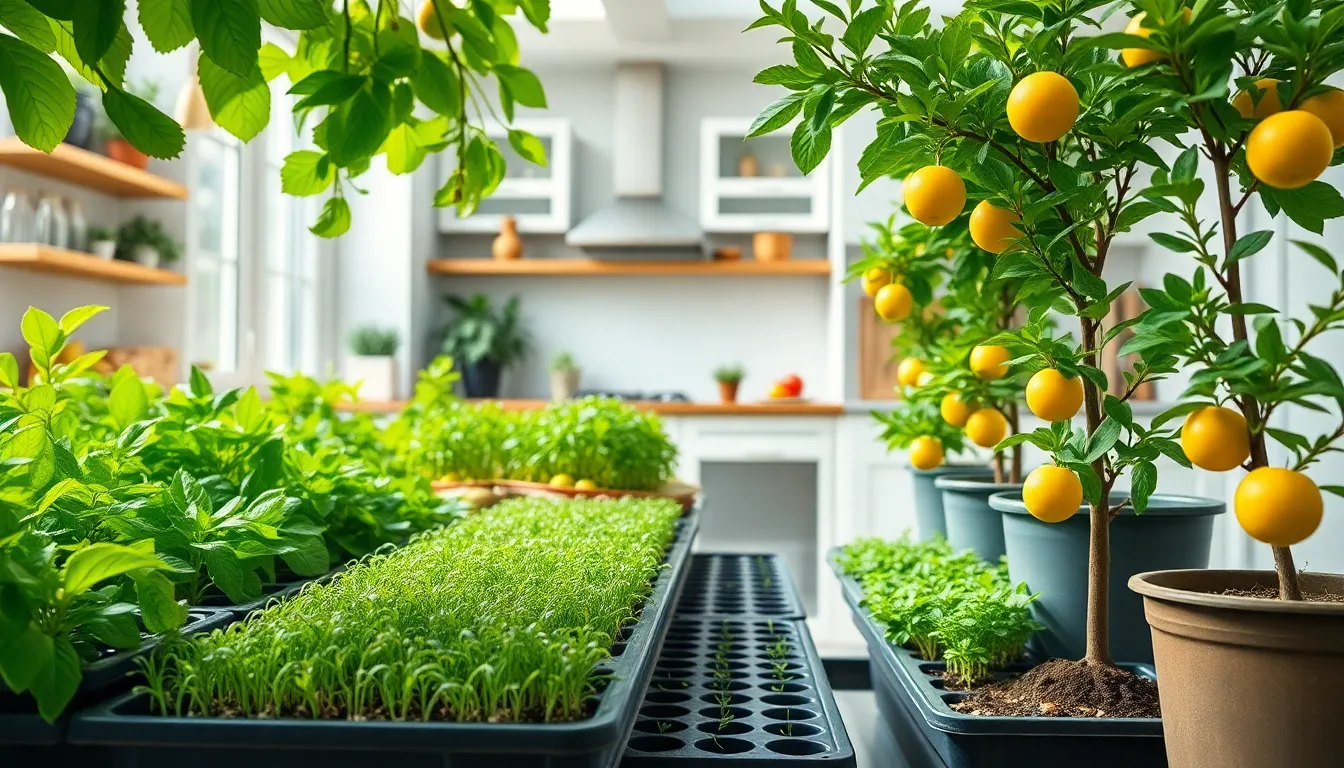
Building on our air-purifying plant knowledge, we can elevate our indoor gardening experience by cultivating edible plants that deliver fresh ingredients directly to our kitchen tables. These productive indoor gardens transform our homes into year-round growing spaces that reduce grocery bills while providing unmatched freshness.
Fast-Growing Vegetables for Indoor Cultivation
Leafy greens offer the quickest path to fresh harvests in our indoor gardens. Arugula reaches maturity in just 3-4 weeks, while kale and chard provide continuous harvests within 30-40 days of planting. Lettuce varieties like oakleaf and buttercrunch produce tender leaves in 25-35 days, making them perfect for impatient gardeners seeking rapid results.
Root vegetables adapt surprisingly well to container growing when we select compact varieties. Baby carrots mature in 50-60 days in deep containers, while small beet varieties like Detroit Dark Red produce sweet roots in 45-55 days. Radishes emerge as champion speed growers, delivering crisp results in just 20-30 days from seed to harvest.
Asian greens excel in indoor environments with their rapid growth cycles. Bok choy reaches harvest size in 30-45 days, while mizuna and tatsoi provide tender leaves within 21-35 days. These nutrient-dense vegetables thrive in cooler indoor temperatures and tolerate lower light conditions better than many Western vegetables.
Microgreens and Sprout Growing Systems
Microgreens deliver concentrated nutrition in remarkably short timeframes. These miniature vegetables reach harvest size in just 7-14 days, requiring minimal space and basic equipment like shallow trays and potting mix. Popular varieties include broccoli, radish, and pea shoots, each offering intense flavors and vibrant colors that enhance our daily meals.
Sprouting systems require even less space and equipment than microgreens. We can grow fresh sprouts in mason jars, specialized sprouting trays, or simple mesh-lid containers within 3-7 days. Mung beans, alfalfa, and lentil sprouts provide protein-rich additions to salads and sandwiches with virtually no soil or light requirements.
Both growing methods complement each other perfectly in our indoor gardens. Microgreens need shallow soil and indirect light, while sprouts thrive in dark, humid conditions with regular rinsing. This combination allows us to maintain continuous harvests of fresh, living foods throughout the year regardless of outdoor weather conditions.
Fruit Plants Suitable for Indoor Growing
Dwarf citrus trees bring tropical flavors to our indoor spaces when provided proper care. Meyer lemons and key limes adapt well to large containers, producing fragrant flowers and flavorful fruits with adequate sunlight or grow lights. These plants require consistent temperatures between 60-70°F and benefit from occasional outdoor placement during warm months.
Strawberry plants offer sweet rewards in compact growing systems. Alpine varieties like Alexandria produce small, intensely flavored berries continuously throughout the growing season. We can grow these plants in hanging baskets or tiered planters, maximizing our vertical space while enjoying fresh berries year-round.
Fig trees provide Mediterranean flavors in surprisingly manageable indoor plants. Dwarf varieties like Petite Negra reach only 6-8 feet in containers while producing full-sized, sweet fruits. These plants tolerate indoor conditions well and enter dormancy during winter months, making them ideal for seasonal indoor growing cycles.
Low-Light Gardens That Thrive in Darker Spaces
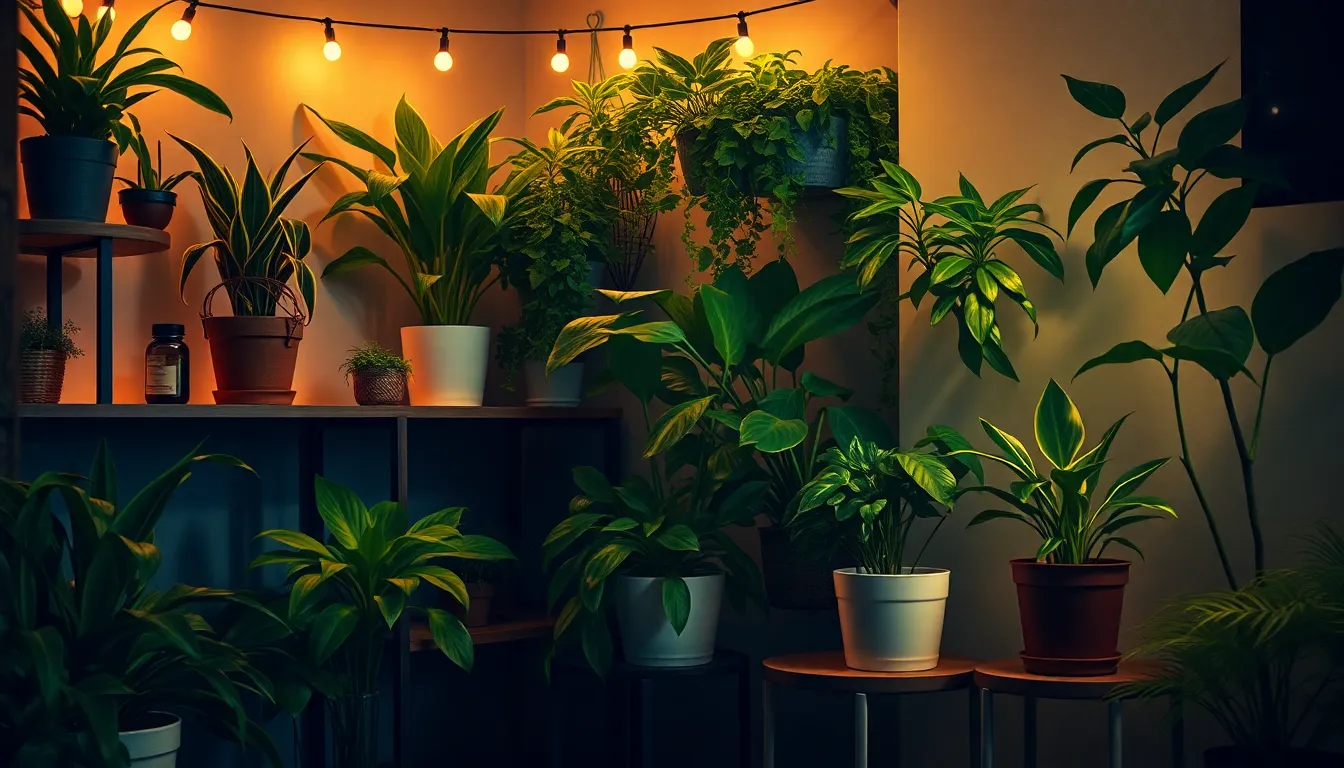
Darker corners and rooms without abundant natural light don’t have to remain barren. We can transform these challenging spaces into lush indoor gardens with the right plant selections and lighting strategies.
Shade-Tolerant Plant Varieties
Dracaena plants lead our list of low-light champions, with snake plants being particularly hardy options that survive in minimal lighting conditions. These architectural beauties require little maintenance while adding striking vertical elements to any space.
Zamioculcas zamiifolia (ZZ plant) stands out as nearly indestructible, thriving in very low light situations where other plants would struggle. Its glossy leaves reflect available light, helping brighten darker areas naturally.
Aspidistra earns its nickname as the cast-iron plant through remarkable hardiness in dark environments. Victorian gardeners relied on this dependable species for poorly lit parlors, and it remains equally reliable today.
Philodendron varieties offer versatility across different lighting conditions, adapting well to low-light spaces while providing lush foliage. These climbing or trailing plants work beautifully in hanging baskets or on plant stands.
Pothos tolerates low-light environments even though preferring indirect light, making it perfect for offices and bathrooms. Its trailing vines create cascading effects that add movement to static spaces.
Bird’s Nest Fern brings unique texture with rippled edges while being completely pet-friendly for households with animals. This tropical species adds an exotic touch to darker indoor gardens.
Peace Lily combines elegant white blooms with air-purifying capabilities, making it both beautiful and functional. Its dramatic leaves create bold statements even when not flowering.
Artificial Lighting Answers
LED grow lights provide energy-efficient supplemental lighting suitable for wide ranges of plants in low-light areas. Modern LED systems consume minimal electricity while delivering full-spectrum light that supports healthy growth.
Fluorescent lights deliver both cool and warm light spectrums necessary for plant development in darker spaces. These affordable options work well for larger indoor garden setups where multiple plants need consistent lighting.
HPS (High Pressure Sodium) lights serve plants requiring intense light levels that can’t be met through natural sources alone. Professional growers often choose these powerful systems for serious indoor cultivation projects.
Timer systems automate lighting schedules, ensuring plants receive consistent daily light cycles without constant monitoring. Smart timers can simulate natural sunrise and sunset patterns for optimal plant health.
Creating Ambiance in Low-Light Areas
Reflective surfaces maximize available light by bouncing illumination throughout darker spaces using mirrors or glossy decorative items. Strategic placement of reflective elements can double the perceived brightness in low-light gardens.
Light-colored decor brightens darker spaces by reflecting rather than absorbing available light sources. White or cream-colored pots, plant stands, and wall colors create more luminous environments for both plants and people.
Soft lighting additions like table lamps or string lights create cozy atmospheres while providing gentle supplemental illumination. These ambient light sources enhance the garden’s visual appeal during evening hours.
Textural contrasts between smooth and rough plant surfaces add visual interest even in limited lighting conditions. Combining plants with different leaf shapes and sizes creates ever-changing displays that remain captivating in darker spaces.
Themed Garden Rooms That Reflect Personal Style
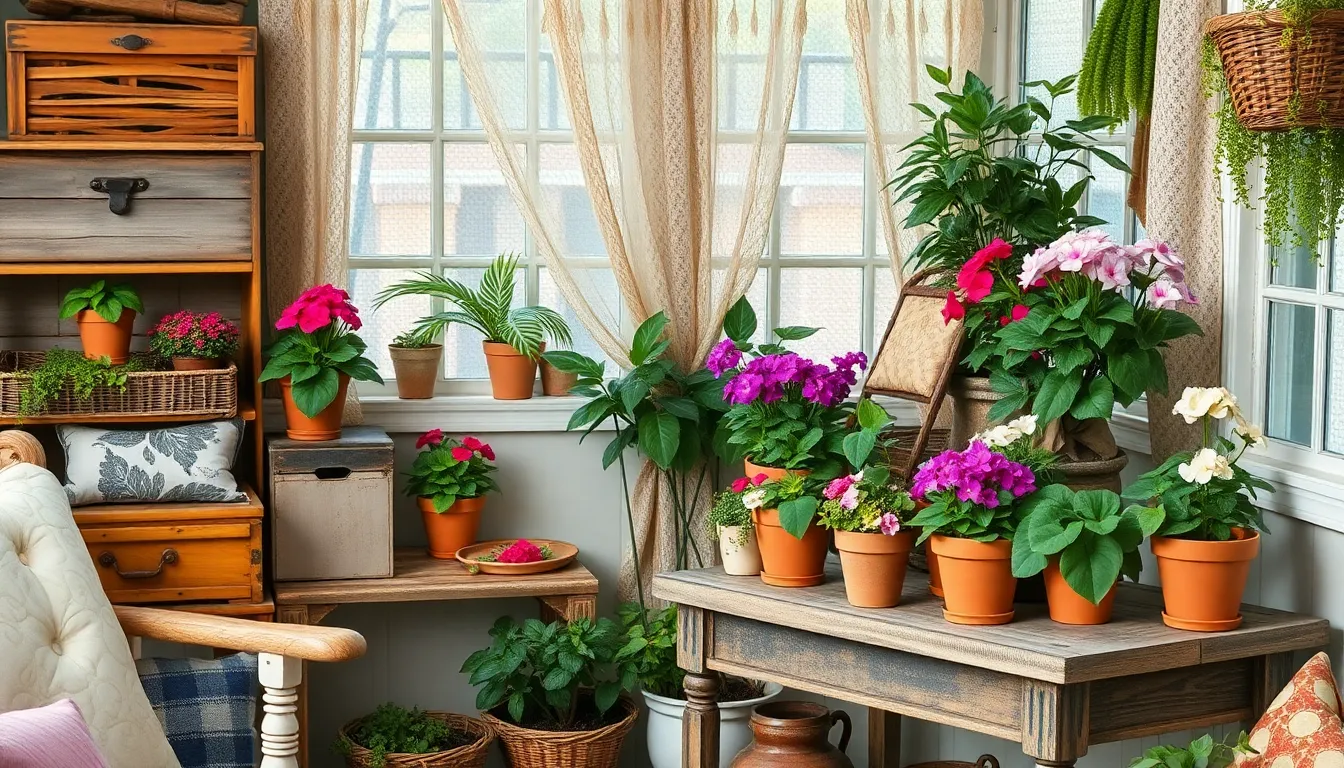
Moving beyond basic indoor gardening, we can create themed garden rooms that express our unique aesthetic preferences and lifestyle choices. These specialized spaces allow us to cultivate plants while establishing distinct atmospheres that reflect our personality.
Tropical Paradise Indoor Gardens
Exotic plants form the foundation of tropical paradise indoor gardens, transforming ordinary rooms into lush retreats. We select vibrant specimens like Bird of Paradise, Monstera deliciosa, and Fiddle Leaf Figs to create dramatic focal points. Palm varieties including Areca palms and Parlor palms add authentic tropical texture while thriving in indoor conditions.
Colorful accents enhance the tropical ambiance through strategic decor choices. We incorporate bright orange, coral, and turquoise elements through planters, cushions, and artwork. Natural materials like bamboo, rattan, and teak furniture complement the lush greenery while maintaining the tropical aesthetic.
Water features complete the paradise experience by adding soothing sounds and humidity. We install small tabletop fountains or wall mounted water elements that mimic tropical rainfall. These features also benefit our plants by increasing ambient moisture levels naturally.
Minimalist Zen Garden Concepts
Natural materials define minimalist Zen garden concepts through careful selection of stone, bamboo, and unfinished wood elements. We choose simple ceramic planters in neutral tones to house our plants without visual distraction. Clean lines throughout the space create harmony between furniture, containers, and plant arrangements.
Minimal decor emphasizes the beauty of negative space and thoughtful plant placement. We select just 3-5 carefully positioned plants like Snake plants, Peace lilies, or single specimen bonsai trees. Calming colors including soft greens, warm beiges, and pure whites promote relaxation and mental clarity.
Meditation areas within these gardens provide spaces for quiet reflection among our plants. We arrange floor cushions near larger specimens or create small seating nooks surrounded by carefully pruned greenery. The absence of clutter allows us to focus entirely on the natural beauty of our chosen plants.
Cottage-Style Indoor Garden Designs
Vintage decor creates the cozy charm characteristic of cottage style indoor gardens through antique watering cans, weathered wooden boxes, and repurposed furniture pieces. We incorporate distressed finishes and aged patina elements that suggest years of loving use. Wicker baskets and galvanized metal containers serve as both functional planters and decorative accents.
Floral elements dominate cottage garden designs through abundant blooming plants and traditional patterns. We grow African violets, Geraniums, and Begonias in terra cotta pots grouped on vintage plant stands. Soft colors including dusty rose, sage green, and cream create the gentle palette that defines cottage aesthetics.
Layered textures through quilted cushions, lace curtains, and natural fiber rugs complete the cottage atmosphere around our garden displays. We arrange plants at varying heights using vintage stools, stacked books, and tiered plant stands to create visual depth and interest throughout the space.
Conclusion
Creating an indoor garden transforms any space into a living sanctuary that brings nature’s beauty directly into our homes. Whether we’re cultivating fresh herbs on a sunny windowsill or building elaborate hydroponic systems we’ve discovered that indoor gardening offers endless possibilities for every lifestyle and space constraint.
The journey from seed to harvest becomes even more rewarding when we can enjoy fresh ingredients year-round while breathing cleaner air. Our indoor gardens serve as both functional food sources and stunning decorative elements that reflect our personal style and creativity.
Starting small with a few herbs or succulents allows us to build confidence before expanding into more complex systems. With the right plants lighting and care routine we can maintain thriving indoor gardens that provide fresh produce beautiful greenery and a deeper connection to nature regardless of the season outside.
Frequently Asked Questions
What are the main benefits of indoor gardening?
Indoor gardening offers numerous advantages including improved air quality, reduced grocery bills, and year-round access to fresh herbs and vegetables. It transforms any space into a vibrant oasis, provides rewarding growing experiences, and allows urban dwellers with limited outdoor access to enjoy gardening regardless of weather conditions.
Which herbs are best for growing indoors?
Popular herbs for indoor cultivation include basil, mint, parsley, chives, rosemary, and oregano. These herbs offer unique flavors and have manageable growing requirements. They thrive in containers placed near windows with good sunlight exposure and can enhance your culinary experiences with fresh, aromatic ingredients.
What are the easiest succulents to grow indoors?
Low-maintenance succulents perfect for beginners include Haworthias, Gasterias, Aloe Vera, String of Bananas, and Christmas Cactus. These varieties require minimal care, offer unique visual appeal, and add modern elegance to indoor spaces while being forgiving to new gardeners.
How can I create a vertical garden in small spaces?
Maximize limited space with wall-mounted planter systems, modular wall units, hanging baskets, and macramé plant hangers. DIY options include upcycled materials, pallet gardening, and ladder gardens. These solutions allow you to grow plants vertically while creating visual interest and maximizing growing space.
What is hydroponic gardening and how do I start?
Hydroponic gardening uses nutrient-rich water instead of soil to grow plants, ensuring year-round harvests. Beginner-friendly systems like AeroGarden and Click & Grow Smart Garden simplify the process. This method is perfect for growing leafy greens, herbs, Asian vegetables, and microgreens indoors.
Which plants work best for low-light areas?
Shade-tolerant plants like Dracaena, ZZ plants, Aspidistra, Philodendron, and Pothos thrive in darker spaces with minimal natural light. You can supplement with LED grow lights or fluorescent lights to support healthy growth in areas with limited sunlight exposure.
What plants are best for air purification indoors?
Top air-purifying plants include Snake Plant, Golden Pothos, Ficus, and English Ivy. These plants remove harmful pollutants from indoor air while providing beautiful greenery. Place them strategically in areas with minimal airflow and near pollution sources for maximum air-cleaning benefits.
How do I maintain a terrarium garden?
Terrarium care involves proper lighting, careful watering schedules, and humidity management. Closed terrariums need plants like ferns and Fittonia that thrive in humid conditions, while open terrariums work well with succulents and herbs that benefit from better air circulation.
What vegetables can I grow indoors year-round?
Fast-growing vegetables like arugula, kale, radishes, compact root vegetables, and Asian greens work well indoors. Microgreens and sprouts require minimal space and equipment for continuous harvests. Fruit plants like dwarf citrus trees, strawberries, and fig trees can also thrive in containers.
How do I optimize window sill gardening?
Choose herbs like basil, mint, and rosemary, plus microgreens and succulents for window sills. Utilize south-facing windows for maximum light exposure, maintain consistent temperatures, and use reflective surfaces to enhance light availability. Consider seasonal rotations to match changing light conditions throughout the year.
